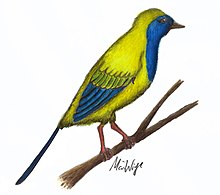| Liaoxiornis Temporal range: Early Cretaceous, | |
|---|---|
 | |
| Scientific classification | |
| Domain: | Eukaryota |
| Kingdom: | Animalia |
| Phylum: | Chordata |
| Clade: | Dinosauria |
| Clade: | Saurischia |
| Clade: | Theropoda |
| Clade: | Avialae |
| Clade: | † Enantiornithes |
| Genus: | † Liaoxiornis Hou & Chen, 1999 |
| Species: | †L. delicatus |
| Binomial name | |
| †Liaoxiornis delicatus Hou & Chen, 1999 | |
| Synonyms | |
| |
Liaoxiornis is a dubious genus of enantiornithean bird. The only named species is Liaoxiornis delicatus, described by Hou and Chen in 1999. [1] Because the species was named for a hatchling specimen, it cannot be matched with adult specimens, and so it is impossible to determine which, if any, birds from the same rocks represent adults of this species. Luis Chiappe and colleagues therefore regarded it as a nomen vanum ("empty name") or at least a nomen dubium, and recommended that use of the name be abandoned. [2]



